23 freely accessible Black history collections
Happy Black History Month! A year ago we shared a selection of image and primary source collections on Artstor and JSTOR that focused on Black history. Today, we have more than 20 community-contributed collections to add to that list—all free to access and download on JSTOR.

Cover of Black Dialogue, 07-01-1970, from Reveal Digital’s Independent Voices collection
Black American Independent Voices (Reveal Digital)
Independent Voices provides scholars unprecedented access to writings and thoughts of those who led and participated in movements such as Black Power, the Black Arts Movement, Black Nationalism, Separatism, and Black Feminism.
Black Perspective (Lehman College, CUNY Leonard Lief Library)
A student-initiated cultural publication, Black Perspective was published from April 1972 to October 1974, and its 20 issues focused on the perceived needs and concerns of Black people at Lehman College and in society at large.
Black Empowerment Collection (Meadville Lombard Theological School)
This collection consists of records of and related to the activities of the UUA’s Black Unitarian Universalist Caucus, (BUUC)/Black Affairs Council (BAC), Full Recognition and Funding of BAC (FULLBAC), and the Black and White Alternative (BAWA), with emphasis on Black Empowerment. Materials date from 1961 to 1983 and include correspondence, printed announcements, newsletters, organizational administrative and financial documentation, by-laws, periodicals and published material, some sermons, and audio cassettes.
Blockson Pamphlets (Temple University)
Pamphlets, maps, and lithographs from holdings in the Charles L. Blockson Afro-American Collection. It blends the distant Black past with recent events.
Charles Waddell Chesnutt Collection (Cleveland Public Library)
Family photographs, memorabilia, and manuscripts relating to prominent African American author Charles W. Chesnutt (1858-1932). Chesnutt gained fame for his short stories, essays, and his biography of the anti-slavery leader Frederick Douglass. His stories focused on the folk life of African Americans, civil rights, and racial intermarriage.
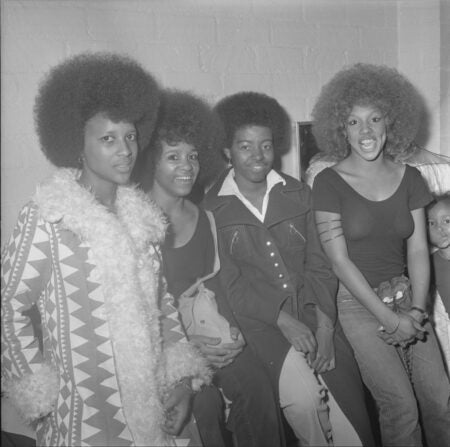
Willie Ford, Jr. Three women and a man sitting for a picture, ca. 1970-1976. From the California State University, Los Angeles’s Compton Communicative Arts Academy Collection
Compton Communicative Arts Academy Collection (California State University, Los Angeles)
The Compton Communicative Arts Academy (CCAA) Archive is a project to preserve and provide access to a collection of images that document African American art and culture in Los Angeles during the early 1970s. These photographs, all taken by Willie Ford, Jr. illustrate buildings and places; the Academy’s programming, artwork, and performances; and artists, artwork, important people, and events.
Huston-Tillotson University
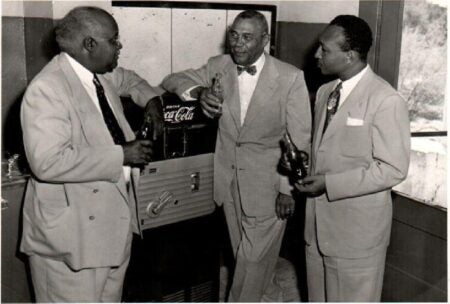
Left to right: Dr. William H. Jones, President of Tillotson College; Dr. Matthew Simpson Davage, President of newly merged Huston-Tillotson College; and Dr. Robert F. Harrington, President of Samuel Huston College. From Huston-Tillotson University’s Charter Day Collection.
- Dr. Mary E. Branch Papers
The daughter of former slaves who became part of the small but developing Black middle class, Branch joined the faculty at Virginia State College and taught there for twenty years. During her career she would be awarded two honorary doctorates: the Doctor of Pedagogy from her alma mater Virginia State College and the Doctor of Laws from Howard University. - Dr. John Q. Taylor King papers
Dr. John Quill Taylor King, Sr. was president of Huston-Tillotson from 1965 to 1988. Dr. King obtained the rank of major general in the army, and in 1985 was appointed to be a lieutenant general in the Texas State Guard. Dr. King also served as dean of Huston-Tillotson starting in 1960, a position he held until being appointed as president of the college in 1965. He retired in 1988 and was named chancellor and president emeritus. He continued to serve the college after this, being named the director and chairman of the Center for the Advancement of Science, Engineering, and Technology, a research branch of Huston-Tillotson. - Dr. Karl E. Downs papers
Dr. Karl Everett Downs became Samuel Huston College’s president at the age of 31, becoming the youngest president of a college or university at the time. While in this position, enrollment increased significantly, from 174 students to more than 600. Downs also invited Jackie Robinson to be the head of the athletics department of Samuel Huston College before his rise to fame as a baseball player. - Dr. Reuben S. Lovinggood papers
Dr. Reuben Shannon Lovinggood was Samuel Huston College’s first African American president in 1900 and remained in that position until his death in 1916. - Huston-Tillotson Charter Day Collection
Huston-Tillotson Charter Day occurred on October 24, 1952, and was the merging of two local African American Colleges in Austin, Texas: Samuel Huston College and Tillotson College. Charter Day is celebrated each year in October.
The Louisiana Works Progress Administration (LWPA): Slave Narratives collection (Southern University)
Fifty first-person accounts and some reproductions of interviews with former slaves. These narratives were collected in the 1940s as part of the Louisiana branch of the Federal Writers’ Project (FWP) of the Works Progress Administration (WPA). Please note that some of the words and descriptions in the collection can be considered offensive; the materials are presented to provide a true historical treatment of how Black Americans were treated.
Malaika Handbooks (University of Miami)
Handbook published by the United Black Students organization in the 1970s and 1980s that lists resources and organizations by and for Black students and faculty.
Meadville Lombard Theological School
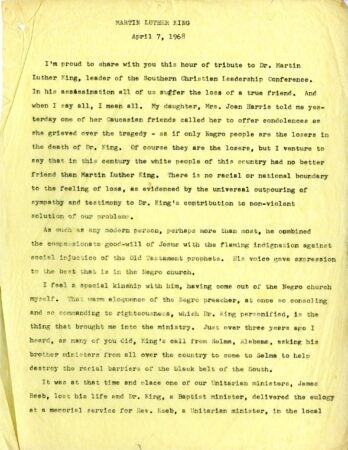
Lewis A. McGee, “Martin Luther King,” 1968. From Meadville Lombard Theological School’s Lewis McGee Papers
- Yvonne Seon Papers
The personal papers of Unitarian minister, activist, and African American Studies scholar Reverend Dr. Yvonne Seon from 1983 to 2014. It includes correspondence, sermons, ministerial organization and congregational papers, photographs, and other writing. - Lewis McGee Papers
The personal papers of Unitarian minister and activist Reverend Lewis A. McGee from 1915 to 1982. McGee, one of the first African American ministers in the Unitarian church, was a humanist, and his experience in an integrated Army led to his interest in creating an interracial congregation. The collection includes sermons, orders of service, correspondence, church bulletins, and newspaper clippings.
Obama Visual Iconography (Cornell University)
Political campaign publicity and memorabilia documenting the campaign and election of President Barack Obama, providing a unique visual iconography of the election of America’s first Black President.

Unknown photographer. Prophet in Black and Landscape, 1935. From Rhode Island College’s Nancy Elizabeth Prophet Collection.
Nancy Elizabeth Prophet Collection (Rhode Island College)
The first woman of color to graduate from the Rhode Island School of Design in 1918, Prophet is remembered for her work in Paris during the 1920s and 1930s. Her work is represented in the permanent collections of the Whitney Museum, the Brooklyn Museum, and the Rhode Island School of Design Museum.

The Oregon Advance Times, September 19, 1968. From Portland State University’s Verdell Burdine and Otto G. Rutherford Family Collection
Verdell Burdine and Otto G. Rutherford Family Collection (Portland State University)
Verdell A. Burdine Rutherford (1913-2001) and Otto G. Rutherford (1911-2000) helped lead the struggle for civil rights in Oregon in the twentieth century. The Rutherfords’ tireless community engagement including work with social, church, uplift, and labor organizations, is reflected throughout the collection which includes materials related to the Portland NAACP, local women’s social organizations such as the Culture Club, the Freemasons and other fraternal organizations, railroad workers’ unions, and local and regional Black-owned businesses. In addition, the collection boasts hundreds of photographs spanning over one hundred years of family history and local community life.
University of North Carolina, Charlotte: J. Murrey Atkins Library
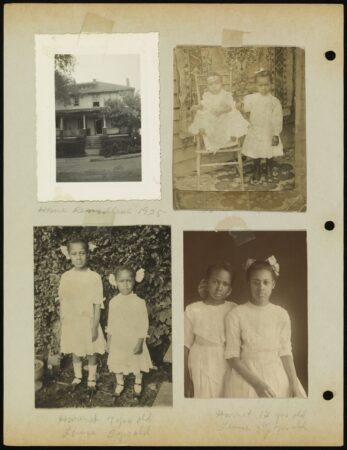
Page from the Taylor and Richardson families album. From the University of North Carolina, Charlotte: J. Murrey Atkins Library’s Taylor and Richardson families album, 1876-1953
- Carver College Records, 1957-1965
Records relating to a two-year college in Charlotte that served Black students during the era of segregation. Contains catalogs, annual reports, curriculum proposals, planning documents, and building plans. - Fred D. (Frederick Douglas) Alexander Papers
Papers and photos of the first African American member of the Charlotte City Council in the 20th Century (1965-74) who also served as a North Carolina state senator (1975-80).
- Taylor and Richardson families album, 1876-1953
Photographs and other materials that document the life of an African American barber, soldier, and firefighter active in social and political causes in Charlotte, NC, and his family.
Williams W. & Mary E. Williams Collection (Mount Zion Baptist Church Preservation Society)
A digital album showcasing selected materials from the Williams W. & Mary E. Williams Collection. The collection includes photographs of Black life in Ohio from the mid-1800s to the 2000s. Material types include tintype, carte de visite, cabinet card, Polaroid, and other photographic and paper records.
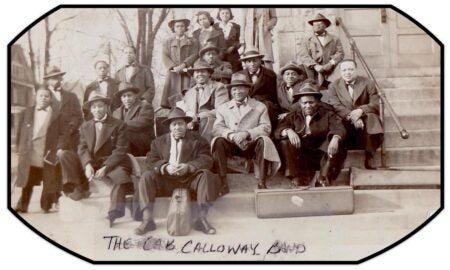
The Cab Calloway Band, from the Athens Black Family Legacy Album, 1890-1939. From the Mount Zion Baptist Church Preservation Society’s Williams W. & Mary E. Williams Collection.
We Choose Freedom: Samaná, Dominican Republic (The City College of New York)
Documents from the African American residents of Samaná, who emigrated in 1824 from different ports along the Eastern United States to what was then the Republic of Haiti. Many of these new immigrants were given land and established communities in Puerto Plata, Santo Domingo, and Samaná in what is today the Dominican Republic. The collection contains birth, marriage, and baptismal records from 1909 to 1970.